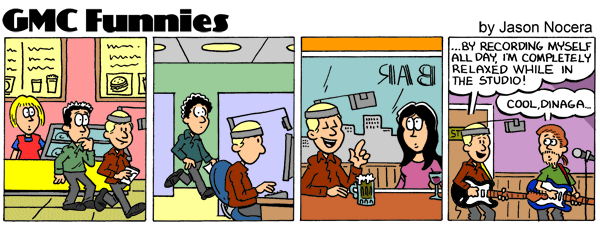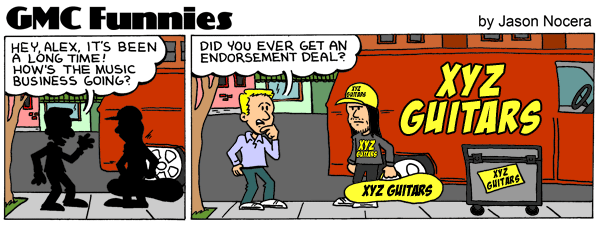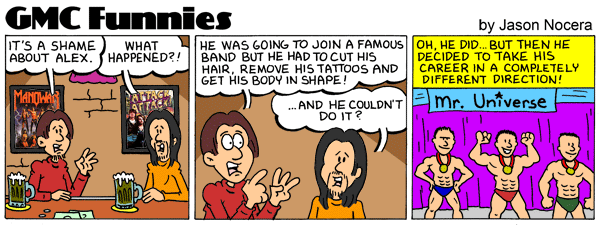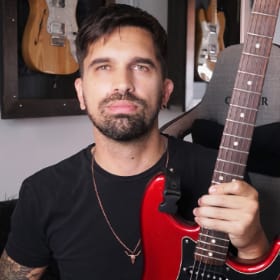Modes Of The Major Scale |
|
|
|
|
|
| Jun 2 2012, 11:26 AM |
|
Hey mates
I would suggest a different approach: don't look at modes as if they were only some shapes. You can regard a scale as an icecream and modes can be different flavors. They are still being icecream but they taste and smell different Each mode has a characteristic sound which can be emphasized if you know what notes to play in a specific context. If you play a whole bunch of notes consecutively, you might end up with some runs but you won't obtain that certain flavor. I have dealt with a series of video chat on modes, in which I have explained the important notes to be emphasized in each particular mode. You can start looking on these lesson notes here and follow them to the present day: https://www.guitarmasterclass.net/guitar_fo...st&p=564197 The principles are the same, but there are a lot of interesting applications and I will assist with answers if you guys stumble upon ideas and concepts which are troublesome in these notes It is good to know the shapes, but it is more important to know which notes make up a mode, which is the characteristic scale degree (the note/ notes offering the specific flavor of that mode) and how to use it in a context. hope this helps Cosmin |
|
|
||
|
|
|
|
| Jun 2 2012, 02:55 PM |
|
Aye, a problem with learning them as shapes and saying to yourself "Well, I'll just emphasize the root note and I'll be fine" is that there are signature notes in each mode that make it sound like it does. Take the Lydian mode, for instance. The only difference between the Lydian and Ionian is that the Lydian has a sharp fourth, instead of the Ionian regular fourth. If you don't play this note, even if you're emphasizing the root, it'll just sound Ionian. So, sure, as Cos said, learn why each mode has a certain 'flavour' to get the most out of it. Otherwise, you may struggle to get a particular sound out of a mode, even after playing about with all those shapes. Not saying that learning the shapes is a bad idea, but you really have to do both to get the most out of it. Okay this is news to me ! I thought a mode was just a reordering of the major scale . So I thought the Lydian Mode was A major scale played from D to D ? I thought the notes stayed the same ? And now you are taking about playing the different notes such as a sharp 4th . Which in essence makes sense . So I guess my next step is to go back to the drawing board and learn the different notes in the modes ? Hi guys, Thanks and sorry to mislead you JesseJ with my over-simplified approach. It was just the way that the logic of modes clicked for me. Is using the 'important' notes to emphasise the mode similar to 'chord-tone soloing'? I can't/don't do that either but know it's important to sounding good Regards Not at all ! everything helps Hey mates I would suggest a different approach: don't look at modes as if they were only some shapes. You can regard a scale as an icecream and modes can be different flavors. They are still being icecream but they taste and smell different Each mode has a characteristic sound which can be emphasized if you know what notes to play in a specific context. If you play a whole bunch of notes consecutively, you might end up with some runs but you won't obtain that certain flavor. I have dealt with a series of video chat on modes, in which I have explained the important notes to be emphasized in each particular mode. You can start looking on these lesson notes here and follow them to the present day: https://www.guitarmasterclass.net/guitar_fo...st&p=564197 The principles are the same, but there are a lot of interesting applications and I will assist with answers if you guys stumble upon ideas and concepts which are troublesome in these notes It is good to know the shapes, but it is more important to know which notes make up a mode, which is the characteristic scale degree (the note/ notes offering the specific flavor of that mode) and how to use it in a context. hope this helps Cosmin Okay so here is what I am to do . 1 learn which notes make up a mode 2 learn and memorize the notes on every string so I know where my root notes are at all times 3 learn to play all the modes on the guitar ( this is why I wanted to know about the shapes. I dont want to be stuck trying to make a solo and only knowing the dorian mode in one spot . I want my fingers to be free to play anywhere on the neck . -------------------- Never miss an opportunity to play
|
|
|
||
|
|
|
|
| Jun 3 2012, 12:11 AM |
|
Great thread! I agree with Cosmin about learning each mode as a scale itself, and not as a shape. You can play the shape but if you don't know which the most important notes are, you won't get its characteristic sound.
Check this cool video about modes by the master Guthrie Govan. -------------------- My lessons
Do you need a Guitar Plan? Join Gab's Army Check my band:Cirse Check my soundcloud:Soundcloud Please subscribe to my:Youtube Channel |
|
|
||
|
|
|
|
| Jun 5 2012, 04:28 AM |
|
I just wanted to thank everybody for all your help on the modes ! It is so nice to have a guitar community like this where we can bring our questions, problems , look for inspiration , and get some laughs Thanks you for being part of this nice community! -------------------- My lessons
Do you need a Guitar Plan? Join Gab's Army Check my band:Cirse Check my soundcloud:Soundcloud Please subscribe to my:Youtube Channel |
|
|
||
1 User(s) are reading this topic (1 Guests and 0 Anonymous Users)
0 Members:





























